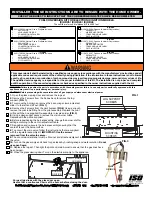
In “Alarm” switching mode, the switching threshold is automatically defined based on
the measurability of the sensor. In this case, the switching output behavior can be
manually selected.
NOTE
The switching mode and the settings can be changed by executing a teach function by
means of a multifunctional input (
see "Multifunctional input (“MF Input”)", page 57
IO-Link (
see "Operation via IO-Link", page 21
NOTE
In addition to the reflection and remission properties of the measuring object, changes
to the angle and distance can have a significant impact on the sensor's ability to
measure.
The sensor's ability to measure is affected not only by the distance and remission
properties of the measuring object, but also by the selected speed setting of the
sensor,
see "Speed setting (“Speed”)", page 62
6.4.1.5.2
Manual settings
Setting
Description
Q
1
Logic
You can use the “Q
1
“ “Q
1
Logic” can be manually selected if the error
output is to act as High Active (
) or Low Active (
).
6.4.1.5.3
Operating examples via display: “Alarm” switching mode
Select and activate the “Advanced” user level
Operating example or steps:
RUN mode
→ Q
1
Output
/
to → Device
→ User level
→ Easy
/
to → Advanced
→ Saved
to → RUN mode
Necessary default settings:
-
Factory setting:
Easy
Activate the “Alarm” switching mode for Q
1
Operating example or steps:
RUN mode
→ Q
1
Output
→ ModeQ
1
→ DtO (1point)
/
to → Alarm
→ Saved
to → RUN mode
Necessary default settings:
User level = Advanced
Factory setting:
DtO (1point)
6
OPERATION
44
O P E R A T I N G I N S T R U C T I O N S | DT50-2 Pro
8017154/1AVV/2021-03-24 | SICK
Subject to change without notice
















































